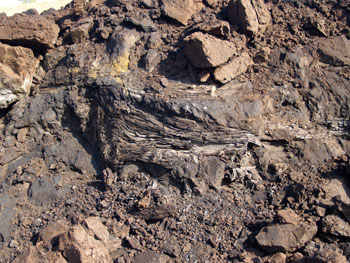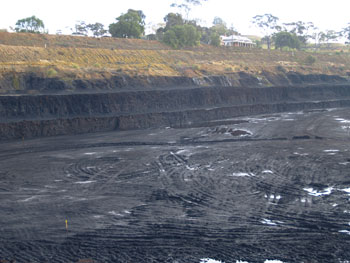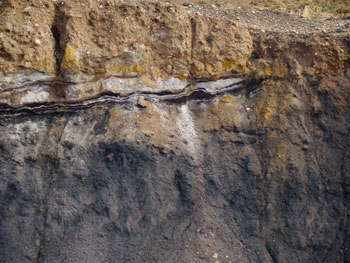
November 2012
Friends of Buckley Park
Fauna monitoring by Trevor Pescott video link
______________________________
October 2012
Volcano Dreaming
Volcano Dreaming has it's own website which can be found here.
______________________________
This section is currently being updated
Below is some information published during production of Volcano Dreaming in 2009.
stage one / geology / fire / sheep / flowerlands / endangered / maybe not endangered but not there anymore / complex ecology / underground / surprises
The outcome of this project is to be a panoramic exhibition scenescape, twelve metres long and two metres high, about the grasslands of the Victorian Volcanic Plains.
The idea is to create one single scene as a backdrop to include pictures of plants, animals, human activities and so on that inform the audience about the ecology of the grasslands and the threats to that ecology.
Technically or logistically this will in effect be a collage of about 3000 photos and images of rocks, trees, grasses, flowers, animals and so on, relevant and important to the story of the Victorian Volcanic Grasslands.
The first stage of the project means working closely with an extensive network of specialists and groups working in a wide range of fields dealing with the status of plants and animals in this degraded and threatened ecosystem.
To put it another way we need to find out what the plants and animals are, where they are, how we photograph them and how we relate them to each other?
A scenescape needs a structure. The Volcanic Plains are so called because they are predominantly made up of material from relatively recent volcanoes that have been active in the last two million to ten thousand years ago. However there are other rocks jutting out here and there created from other geological processes which also are significant in the shape and character of the landscape.
We spoke to a number of Victorian geologists to understand the nature of the volcanoes and how the ground structure of the plains has been shaped. We have also visited quite a number of sites to look at the way lava has come up in different places and what is underneath it. We have also read quite a number of articles, books and reports.
The Royal Society of Victoria and Geological Society of Australia have helped with our research.
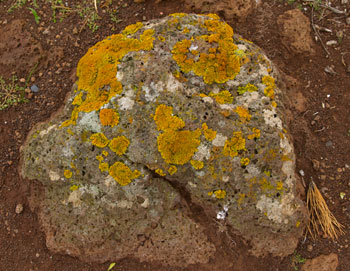
Basalt rock is home to a rich variety of plants and animals including this bright orange Lichen
found at Mt Cottrell.
Many of the topics we are looking at are seasonal, such as fire burns which are usually carried out in the Autumn. Fire is an issue in the history, evolution, maintenance and vitality of grasslands and we needed to work with several agencies, including Parks Victoria to attend and photograph an official burn to witness and record this process.
The introduction of sheep is considered the beginning of the large scale degradation of the grasslands. Researching and photographing something of the scale of this industry has meant visits to the National Wool Museum and looking at sheep in the field.
However the introduction of sheep is just one of a range of factors that have threatened the original ecology of the grasslands and continue to do so.i.
Within six years of John Batman declaring the area around Melbourne the site for a village more than a million sheep were introduced into Victoria, mostly onto the volcanic plains.
Several observers have made the point that these plains were as much flowerlands as grasslands, with a range of orchids, daisies, herbs and other flowering plants that made them a sea of colour in springtime.
Unfortunately such a spread of colour is hard to find. We have had to search far and wide to find remnant patches of vegetation with enough variety and colour to give even some sense of the original impact.
This has also meant travelling several hundred kilometres through the volcanic plains to try and find some more substantial remnant patches.
All of this has been with the help of some very dedicated people from a range of organisations.
People such as Brett McDonald of Brett Lane and Associates and groups like the Hamilton Field Naturalists Club.
We are also being educated on specific species of the plains flowers. Several people, including the Education Officer at Iramoo Sustainable Community Centre, Melissa Doherty, has provided many close-ups of the individual flowers.
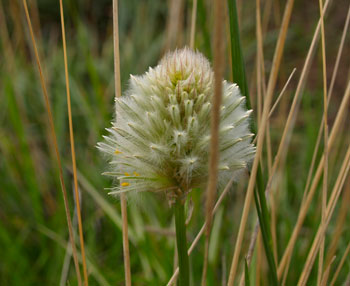
We are discovering that some of the original animals of the plains are very endangered and even extinct. Only a handful of Rock Wallabies are left in the world and they are being protected in a special breeding program at Mount Rothwell.
A very special endangered animal is the bandicoot. Education officer, Michelle Howard at the Werribee Open Range Zoo arranged for us to visit and photograph their resident bandicoot.
maybe not endangered but not here anymore
This is not just about endangered species but also animals once common to the plains, such as emus, which once wandered freely where the sheep now graze. Emus are not so endangered but they are mostly seen in reserves such as Serendip Sanctuary.
Also it is about other animals like crows which are still quite common around the grasslands and the city for that matter.
Every answer leads to another question. The disappearance of plant species can be associated with the disappearance of a whole range of other things like insects that are part of the pollination process of plants.
We have been meeting with specialists from
the Department of Primary Industry entomology section,
the Department of Sustainability,
the Royal Botanical Gardens,
the Indigenous Flora and Fauna Association and others trying to get some understanding and images of a wide range of complex activities with the aim of explaining these in a relatively simple way. If that is possible?

Above - there are some 1200 species of ant in Australia this meat ant was found near Lerdederg Gorge.
Images right from top - ant nests near Wannan Falls, termite larvae underground at Manor Lakes housing estate west of Melbourne, a cricket found in the grasslands at Iramoo Grassland Resrve.
It is becoming apparent that a good deal of the biological exchanges in the grassland ecology take place underground.
Here we have been aided by researchers who are catching up with new research on how some of the plants of the plains find nourishment and reproduce.
We were invited to a research and rescue operation of the endangered plant Pimelea Spinescens by researcher Debbie Reynolds of Victoria University, who has been tracing the root system of these plants deep into the clay soil.
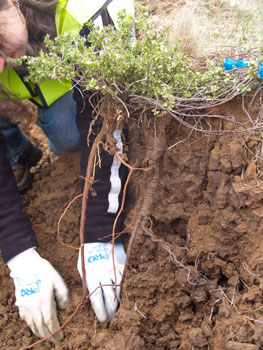
Pimelea Spinescens has an extensive
root system.
Exploring odd niches and corners of the story of the plains has revealed some exciting new insights, for us at least. We tracked down the Maddingley Coal Mine to look at the relatively unknown seam of brown coal from the Miocene age that runs under the Volcanic Plains a couple of hundred feet underground.
The exciting part was that you could still see the shape of trees and bits of wood embedded in the young brown coal. Several million years later and covered with sandstone from a temporary inland sea and later volcanics you can see the trees turning into coal. Fantastic.
And this coal is not used for burning. Farmers buy it to enrich the soil because it is one of the best fertilisers around. It can be bought from Maddingley Minerals
These images show some of the interesting geological formations found at the Maddingley Coal Mine.
Right (from the top) - detail of mine face exposing ancient forest wood, the brown coal face, exposed soil layersabove the coal.
Below, well formed sandstone from an ancient era of under sea activity above the coal.

stage one / geology / fire / sheep / flowerlands / endangered / maybe not endangered but not there anymore / complex ecology / underground / surprises

Would you like to know when this page is updated?
click here to contact us.
To find out more about how and when your organisation
may arrange to borrow or use this display contact us
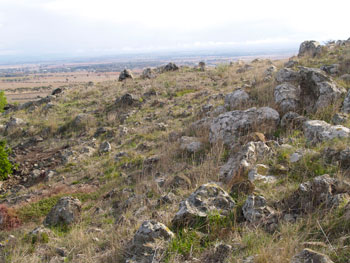
The grasslands of the Victorian Volcanic Plains extend from
the suburban outskirts of Melbourne and stretch more than
400 kilometres westward into country Victoria.
The area includes some 400 volcanos some of which
are extinct and some which are just sleeping.
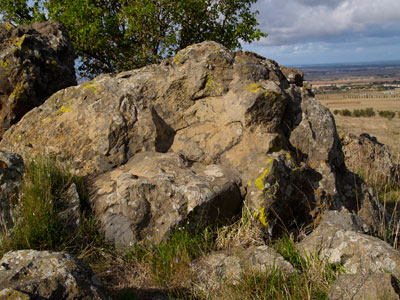
Basalt (or bluestone) outcrops at the top of Mt Cottrell, an
extinct volcano near Melton.
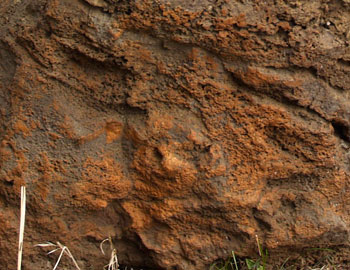
Basalt is made when molten volcanic lava cools down to form rock.
Basalt is found in many shapes and states depending on the make-up
and consistency of the lava and how it was cooled.

Fire management of grasslands.
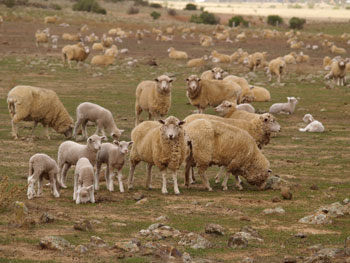
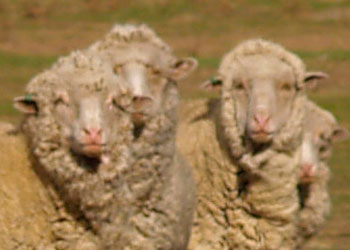

Native bluebells on an escarpment of Little River.

Brett Mc Donald points out orchids shooting between rocks
at the Evans Street Reserve in Sunbury.
Left - A translocated Feather head grass flowering
at Iramoo Sustainable Community Centre.
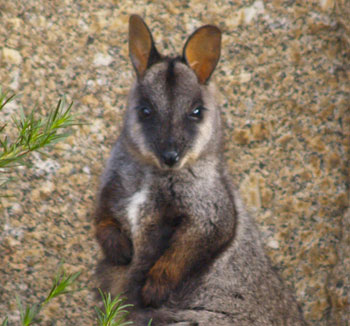
A young female Rock Wallaby at Mt Rothwell.

Emu in captivity at Hamilton Botanical Gardens.
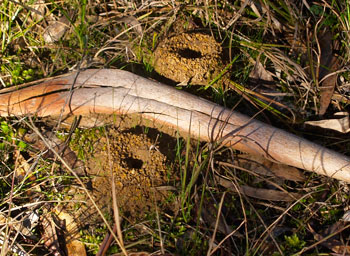
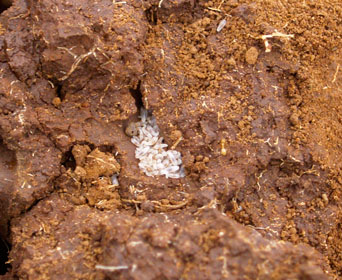

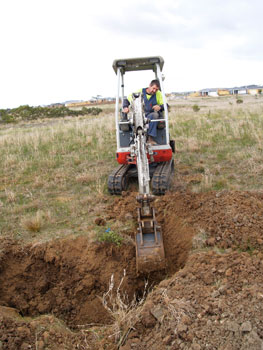
Trenches being dug by Rick Van Keulen very
carefully near to each plant colony.
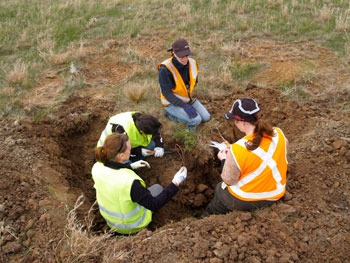
Pimelea Spinescens translocation team led by Debbie Reynolds carefully
reveal each plants root system before translocation.
